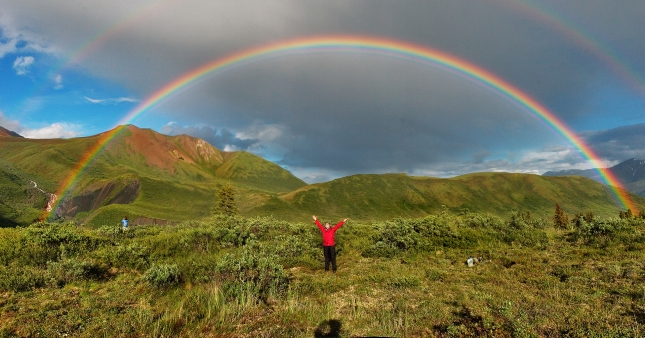Rainbows are visions
They're only illusions
Rainbows have nothing to hide …
From, The Rainbow Connection
Beyond Bubbles : The Essence of Champagne
by Paige Donner
I have never seen so many rainbows as I see when I'm in Champagne. Not even in Hawai'i, that tropical paradise, do rainbows make such frequent appearance.
When the heavens open up like that, displaying this seemingly magical burst of color in the otherwise cold, and very often gray, Champenois landscape, it inspires contemplation.
So with my frequent sightings of these Champagne rainbows – even, often, double rainbows - my mind has delved into the question, what correlation exists between the magic of rainbows, a phenomenon inspired and derived solely from nature, and champagne ?
The locals, the Champenois, recount the tale of the "discovery" of champagne as "a happy accident." Many of us wine aficionados, lovers and champagne connoisseurs are only too familiar with the legend of the tinkering monk of Hautvillers' ancient abbey and how a secondary fermentation of a batch of wine that otherwise would have been termed "bad" or "off" and thrown out, in fact became what is now the world-famous luxury wine product known as champagne.
Does it take a spiritual, singularly visionary person, like a contemplative monk, to perceive the wonder and magic in nature, yes, in God's ways ? And hence the extraordinary potential and wealth of abundance that "happy accidents" often yield ?
That rhetorical question is one for each individual to answer for themselves.
What is of historical record is that a monk inspired the wholesale production method of a wine that had previously, for centuries, dating back at least to King Henry IV's, Henri-Quatre's, time, been a still wine. And with that recognition, he cleared the path for his kinsmen to find that "pot of gold" on the other side of the Champagne rainbow.
Champagne is today the richest viticultural region on Earth and one where the vines are held by thousands of small growers. Nature's "happy accident," and a monk's wisdom to recognize it, now sustains a multi-billion dollar industry whereby thousands of agricultural families enjoy a decent, even above average, standard of living, just by the grace of the yield from God's good Earth. There is no other viticultural region that similarly compares to this abundant socio-economic structure.
As a wine writer, I am tempted here to go into the intricacies of Champagne's chalky terroir, the crayères that date back to Roman times, the Kimmeridgean soil, the ancient lake bed with its fossilized shells that lends itself to this extraordinary viticultural zone, one that uniquely yields the distinctive chardonnay, pinot noir and meunier musts that go into the blending of a fine champagne.
But before all of this, before the whole cult of a wine-with-bubbles was created, spawning tomes of reviews, critiques, analyses and studies, it took one person's penetrating vision and recognition that champagne is not simply a unique wine among the other fabulous French wines, but worthy of value and honor. Vision is all about the ability to perceive. Before any of this mattered, the soils, the cellars, the méthode champenois, it took one person to recognize its potential value. A rose by any other name is still a rose, but there still must be that first who recognizes its valeur. I wonder, who was the first to call champagne the "King of wines?"
Like rainbows, the bubbles in a glass of champagne are ethereal, effervescent, sparkling with nature's magic. They are each – rainbows and bubbles in a bottle of champagne - a natural phenomenon to be enjoyed. They are to be appreciated with the respect that as a product of nature they are a gift, a gift whose pleasure it is to be enjoyed. And like a rainbow, the bubbles in a glass of champagne defy possession, for like love, rainbows and the bubbles in this wine made from Champagne grapes, they cannot be sequestered in one's hand, for only the release of their fleeting essence for precious few scintillating moments, allow these extraordinary occurrences of nature the expression of what they uniquely are.



No comments:
Post a Comment